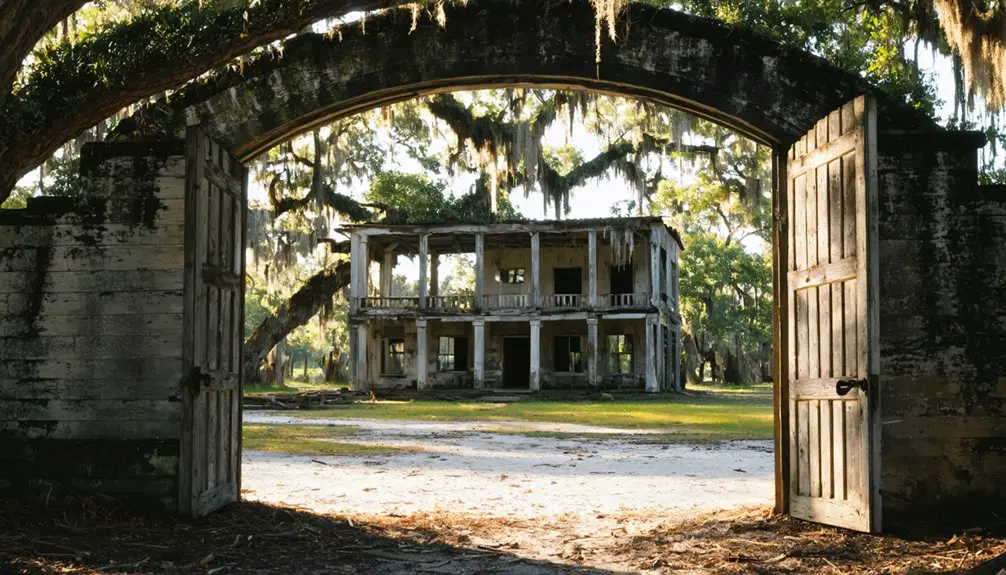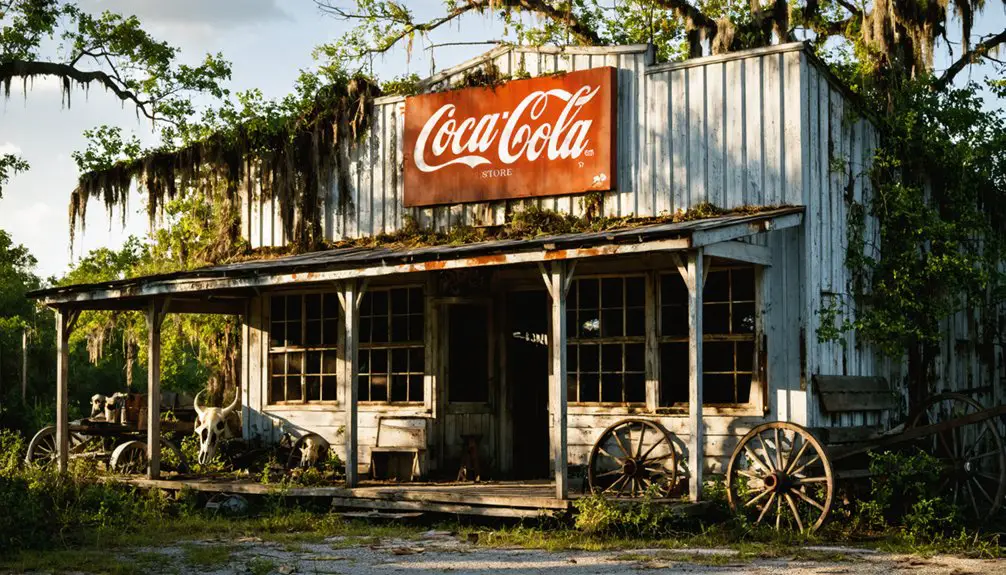You’ll find Fort Kissimmee‘s remains along Florida’s Kissimmee River, where it operated as a military outpost from 1850 to 1858 during the Seminole Wars. The wooden blockhouse and garrison faced constant challenges from malaria outbreaks, supply shortages, and Seminole resistance before its closure. After the military departed, pioneers transformed the site into a ranching community led by Lewis Henry Thomas. The fort’s transformation from military stronghold to ghost town holds deeper mysteries beneath its swampy terrain.
Key Takeaways
- Fort Kissimmee transitioned from a military outpost to civilian settlement after its closure in 1858, eventually becoming abandoned.
- Disease outbreaks, particularly malaria, contributed to the fort’s decline and eventual abandonment as a military installation.
- The original wooden blockhouse and military structures deteriorated after the fort’s closure, leaving minimal physical remains.
- Despite initial civilian settlement efforts led by Lewis Henry Thomas, the community struggled to maintain long-term sustainability.
- The site’s remote location along the Kissimmee River and challenging environmental conditions hindered sustained development.
Military Origins and Strategic Purpose
As tensions mounted between U.S. forces and the Seminole Indians in early 1850, Fort Kissimmee emerged as a significant military outpost along General David Twiggs‘ newly established trail connecting Fort Brooke to Fort Capron.
You’ll find the fort’s military architecture reflected its practical purpose – a wooden blockhouse with minimal outbuildings designed for rapid deployment during hostilities. The strategic positioning along the Kissimmee River gave U.S. forces control over central Florida’s movement and supply routes. The fort’s operations were plagued by supply shortages similar to earlier campaigns.
Troop dynamics proved challenging, with malaria outbreaks limiting garrison strength, yet the fort played a critical role in coordinating multi-column operations to push Seminoles southward. The fort was permanently closed in 1858, leaving behind only its central blockhouse structure.
Though intermittently used at first, the fort’s reactivation in 1855 during the Third Seminole War cemented its importance in protecting newly opened territories for American settlers.
Disease Outbreaks and Early Challenges
The scourge of malaria cast a long shadow over Fort Kissimmee’s early military operations.
You’ll find that repeated outbreaks in the 1850s severely disrupted the fort’s military presence, forcing intermittent abandonments until its reactivation during the Third Seminole War in 1855.
Disease management proved nearly impossible in the frontier environment. The fort’s location near rivers and wetlands created ideal breeding grounds for mosquitoes, which transmitted both malaria and yellow fever. With no effective medicines available, the mortality rates were particularly devastating among the fort’s population.
Hostile mosquito-infested wetlands surrounding Fort Kissimmee made disease control futile, as malaria and yellow fever ravaged the settlement.
Early settlers faced these same health challenges with minimal medical infrastructure to combat the outbreaks. You’ll see how these conditions led to significant population decline, as both military personnel and civilians fled during severe episodes.
The lack of public health measures and proper sanitation in this untamed Florida frontier made sustained settlement an uphill battle.
The Rise of Civilian Settlement
Following the fort’s establishment in January 1850, civilian settlement flourished around Fort Kissimmee‘s strategic location near the Kissimmee River in Highlands County, Florida.
You’ll find the area’s community growth was sparked by the U.S. government’s 1859 decision to open northern Florida for free-range cattle grazing, despite challenges like malaria outbreaks at the fort.
Settlement expansion gained momentum through Lewis Henry Thomas‘s contributions, including land donations for the first church, school, and cemetery. He’d also operate an essential ferry service two miles upriver.
The rugged terrain of sandy swamps, prairie, and pine woods didn’t deter determined settlers like William Henry Willingham and Joseph Underhill, who established thriving cattle operations. Early pioneer Dock Boney settled at Fort Kissimmee, contributing to the area’s development.
They’d adapt to frontier life, building community structures from local materials while developing the valley into a significant cattle-driving region. The area’s growth would continue until the US government evacuated the settlers in 1942 to establish a military bombing range.
Role in the Seminole Wars
You’ll find Fort Kissimmee‘s strategic location beside the Kissimmee River proved crucial for U.S. military operations during the Third Seminole War, enabling troops to monitor and control Seminole movements through central Florida.
Similar to Fort Gardiner’s location, Fort Kissimmee was positioned along vital waterways to maintain strategic control of the region.
The fort’s garrison faced constant challenges from malaria outbreaks and the harsh Florida environment while launching expeditions into contested Seminole territories between 1855 and 1858.
Despite these obstacles, Fort Kissimmee served as a critical link in the military’s network of inland posts, coordinating with Fort Brooke and Fort Capron to maintain supply lines and communication during the conflict.
Military Strategy Location
Situated along the strategic Kissimmee River waterway, Fort Kissimmee played an essential role in the Second Seminole War (1835-1842) by controlling important access routes between Lake Tohopekaliga and Lake Okeechobee.
You’ll find the fort’s position was masterfully chosen to command troop movements and protect northern settlements from Seminole raids. As a northern staging ground, it enabled U.S. forces to launch coordinated campaigns deeper into hostile territory while maintaining critical supply lines. The fort’s commanders faced considerable challenges adapting to the guerrilla warfare tactics employed by their Seminole adversaries.
The fort’s location supported Colonel Zachary Taylor‘s famous December 1837 expedition and Major General Thomas Jesup‘s multi-column strategies. By controlling strategic waterways and trail crossings, it helped trap Seminole groups attempting to break northward and served as a secure base for provisioning large troop assemblies, including regular Army forces and Native American volunteers. The war’s staggering cost of over $30 million strained military resources, making strategic outposts like Fort Kissimmee crucial for efficient operations.
Combat Against Seminole Forces
From its strategic riverside position, Fort Kissimmee became a focal point of intense combat operations during both the Second and Third Seminole Wars.
You’ll find that the fort’s troops regularly launched sweeping patrols along the Kissimmee River, confronting Seminole warriors who masterfully used the dense Florida terrain for guerrilla tactics and hit-and-run attacks.
During the Third Seminole War, particularly after 1855, military engagements intensified as U.S. forces tried pushing Native resistance further south.
Despite challenges from malaria outbreaks, soldiers persisted in their missions to disrupt Seminole movements and supply lines. The army’s campaign under General Sidney Jesup focused on destroying Seminole resources and food supplies to weaken their resistance.
Colonel Zachary Taylor’s forces coordinated multi-column operations from similar forts, though the Seminoles’ adaptive warfare strategies often frustrated conventional military approaches until the conflict’s end in 1858.
Garrison Life Challenges
While serving at Fort Kissimmee during the Seminole Wars, soldiers faced a grueling array of environmental and logistical challenges that tested their resilience daily.
You’d find troops battling extreme heat, high humidity, and swarms of insects while living in basic log stockades with minimal protection.
Environmental hazards included venomous snakes, contaminated water sources, and disease-carrying mosquitoes that spread malaria throughout the garrison.
Supply shortages were common, as swampy terrain made overland routes nearly impossible, forcing reliance on vulnerable river transport.
Soldier morale suffered under the constant strain of isolation, with limited communication to other posts and family.
The combination of tropical diseases, primitive medical care, and the persistent threat of Seminole attacks made garrison life an endurance test of both body and spirit.
The soldiers’ struggles were amplified by their responsibility to care for wounded after Okeechobee, as the fort served as a recovery station following major battles.
Daily Life and Community Development
After Fort Kissimmee‘s military closure in 1858, civilian settlement flourished as hardy pioneers transformed the former military outpost into a tight-knit ranching community.
You’d find settlers demonstrating remarkable community resilience as they carved out lives amid harsh conditions – battling mosquitoes, malaria, and the unforgiving Florida climate.
Lewis Henry Thomas emerged as a pivotal figure, donating land for essential social institutions: the first church, school, and cemetery. These buildings became the heart of community life, while his ferry service helped connect scattered ranch families.
Despite the challenges of living in rugged terrain with swamps and marshes, you’d see how the community banded together, centered around cattle ranching and trading at Parker’s general store, proving their adaptability in this frontier environment.
From Frontier Post to Ghost Town

During the fort’s changeover in 1858, the military presence that had defined Fort Kissimmee steadily dissolved as soldiers departed and buildings fell into disrepair.
Yet the fort’s history didn’t end with its military closure – you’ll find that pioneering settlers transformed the area into a thriving civilian community.
Lewis Henry Thomas and other founding figures donated land for essential infrastructure, while free-range cattle operations expanded across the northern Florida territory after 1859.
Though the original fort structures crumbled, the community legacy lived on through the establishment of the area’s first church, school, and cemetery.
Children would arrive by barge for their education, marking the evolution from a strategic military outpost to an independent settlement shaped by the determination of frontier families.
Frequently Asked Questions
What Artifacts Have Been Recovered From the Fort Kissimmee Site?
You’ll discover diverse pottery like Belle Glade Plain, stone grinding tools, shell blades, wooden ornaments, and baby teeth scattered among lime pits and middens, revealing centuries of native life.
How Many Soldiers and Civilians Lived at Fort Kissimmee During Its Peak?
You’ll find the soldier population peaked at several dozen to low hundreds of troops, with Colonel Taylor’s forces present. Civilian life was minimal, with virtually no permanent residents at the fort itself.
What Happened to the Thomas Family After Fort Kissimmee’s Abandonment?
You’ll find the Thomas family moved to nearby Okeechobee, where they continued ranching traditions. Alan Henry Thomas, born in 1938, lived there his whole life while others spread throughout central Florida’s cattle country.
Were There Any Documented Supernatural Occurrences at Fort Kissimmee?
You won’t find any verified ghostly encounters or paranormal investigations at Fort Kissimmee in historical records. Military archives, local histories, and cemetery documentation show no evidence of supernatural activity there.
Can Visitors Access the Former Fort Kissimmee Site Today?
Like finding Atlantis beneath waves, you’ll struggle to access the site today. There’s no historical preservation or visitor access infrastructure, and you’ll need permission since it’s likely on private land.
References
- https://www.legendsofamerica.com/fort-kissimmee-florida/
- https://www.legendsofamerica.com/fort-basinger-florida/
- https://www.florida-backroads-travel.com/florida-ghost-towns.html
- https://abandonedfl.com/lockett-estate/
- https://www.lamartin.com/history/pioneer_families_kissimmee_river_valley.htm
- https://en.wikipedia.org/wiki/Second_Seminole_War
- https://osceolahistory.org/history-of-kissimmee/
- https://www.osceola.org/Community/About-Osceola-County/General-Information/County-History
- https://en.wikipedia.org/wiki/List_of_forts_in_Florida
- https://blaypublishers.com/wp-content/uploads/2014/08/leb-11-hribar1.pdf



